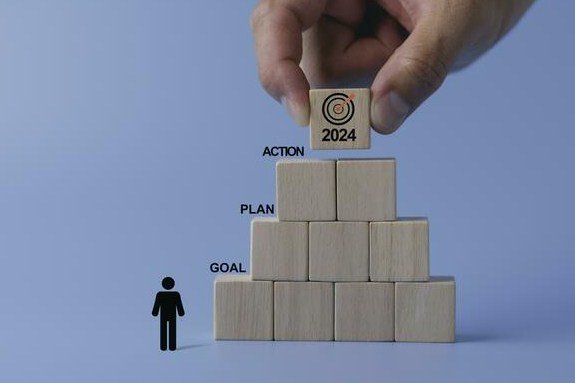As the year 2023 comes to an end, many small business owners are looking ahead to 2024 and setting their goals for the new year. Whether you want to expand your business, invest in new technology, hire more staff, or improve your employees’ well-being, you need a clear and realistic plan to make it happen. In this article, we will share some tips and strategies on how to plan and achieve your small business goals in 2024.
Start with a Vision
The first step to planning your small business goals is to have a vision of where you want your business to be by the end of 2024. What is your mission, your purpose, your values? What are your long-term aspirations and objectives? Having a vision will help you align your goals with your core principles and motivate you to pursue them.
To create your vision, you can use tools such as a vision board, a mind map, or a SWOT analysis. A vision board is a collage of images, words, and symbols that represent your desired future. A mind map is a diagram that shows the connections between your ideas, goals, and actions. A SWOT analysis is a framework that helps you identify your strengths, weaknesses, opportunities, and threats.
Your vision should be specific, measurable, achievable, relevant, and time-bound (SMART). For example, instead of saying “I want to grow my business”, you can say “I want to increase my revenue by 20% and my customer base by 15% by December 31, 2024”.
Break Down Your Goals into Actionable Steps
Once you have your vision, you need to break it down into smaller and more manageable goals. These are the milestones that will help you track your progress and keep you focused on your vision. You can use tools such as a Gantt chart, a Kanban board, or a SMART goal worksheet to organize your goals and tasks.
A Gantt chart is a timeline that shows the start and end dates of your goals and tasks, as well as their dependencies and priorities. A Kanban board is a visual system that helps you manage your workflow and monitor your progress. A SMART goal worksheet is a template that helps you define your goals and actions using the SMART criteria.
Your goals should be divided into three categories: short-term, medium-term, and long-term. Short-term goals are the ones that you can achieve in a few days or weeks. Medium-term goals are the ones that you can achieve in a few months or quarters. Long-term goals are the ones that you can achieve in a year or more.
For example, if your vision is to increase your revenue by 20% and your customer base by 15% by December 31, 2024, your goals could be:
- Short-term: Launch a new marketing campaign by January 31, 2024
- Medium-term: Hire two more salespeople by June 30, 2024
- Long-term: Open a new branch by September 30, 2024
Get Support from Your Team and External Resources
Planning and achieving your small business goals is not a solo endeavor. You need the support and collaboration of your team and external resources to make it happen. You should communicate your vision and goals to your team and involve them in the planning process. You should also delegate tasks and responsibilities according to their skills and strengths. You should also provide feedback and recognition to your team members and celebrate your achievements together.
External resources are the people and organizations that can help you with your goals. They can be mentors, coaches, consultants, advisors, partners, suppliers, customers, or investors. You should identify the external resources that you need and reach out to them. You should also leverage the power of networking and referrals to expand your connections and opportunities.
For example, if your goal is to invest in new technology for your business, you can get support from:
- Your team: Ask them for their input and feedback on the best technology solutions for your business needs. Assign them tasks such as researching, testing, and implementing the new technology.
- External resources: Seek advice from experts and consultants who can help you choose and install the new technology. Partner with vendors and suppliers who can offer you discounts and deals. Ask your customers for their opinions and preferences on the new technology.
Review and Adjust Your Plan Regularly
Planning your small business goals is not a one-time event. It is an ongoing process that requires constant review and adjustment. You should monitor your progress and performance regularly and compare them with your expected outcomes. You should also evaluate your strengths and weaknesses and identify any challenges or opportunities that arise. You should also be flexible and adaptable to changing circumstances and customer needs.
To review and adjust your plan, you can use tools such as a dashboard, a scorecard, or a feedback system. A dashboard is a visual display that shows your key performance indicators (KPIs) and metrics. A scorecard is a tool that helps you measure and improve your performance against your goals and objectives. A feedback system is a method that helps you collect and analyze feedback from your team, customers, and external resources.
You should review and adjust your plan at least once a month, or more frequently if needed. You should also set aside time for quarterly and annual reviews to reflect on your achievements and challenges and to update your vision and goals accordingly.
For example, if your goal is to improve your employees’ well-being, you can review and adjust your plan by:
- Dashboard: Track and display your employee satisfaction, engagement, and retention rates.
- Scorecard: Measure and improve your employee well-being initiatives, such as wellness programs, flexible work arrangements, and recognition schemes.
- Feedback system: Collect and analyze feedback from your employees, such as surveys, interviews, and suggestions.

